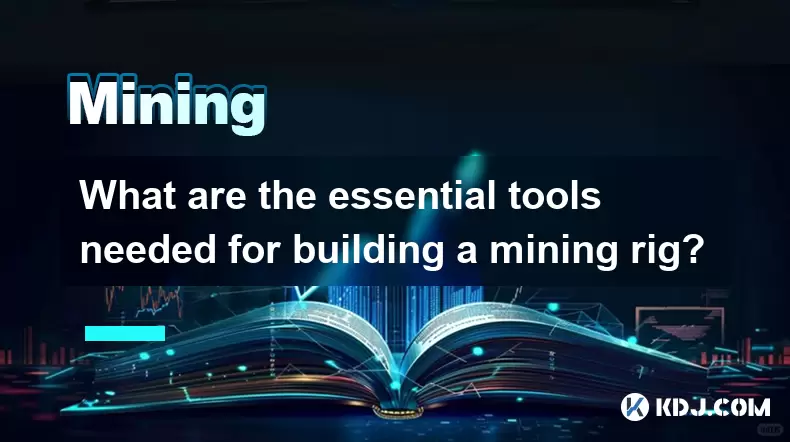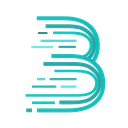-
 bitcoin
bitcoin $122090.672462 USD
1.59% -
 ethereum
ethereum $4493.758974 USD
0.56% -
 xrp
xrp $3.033145 USD
0.65% -
 tether
tether $1.000629 USD
0.00% -
 bnb
bnb $1169.854250 USD
7.07% -
 solana
solana $230.954786 USD
-0.19% -
 usd-coin
usd-coin $0.999785 USD
0.00% -
 dogecoin
dogecoin $0.256108 USD
-1.12% -
 tron
tron $0.342333 USD
-0.12% -
 cardano
cardano $0.859632 USD
-0.10% -
 hyperliquid
hyperliquid $48.932146 USD
-2.25% -
 chainlink
chainlink $22.345466 USD
-1.29% -
 ethena-usde
ethena-usde $1.000217 USD
-0.03% -
 avalanche
avalanche $31.203456 USD
1.93% -
 sui
sui $3.579145 USD
1.05%
What are the essential tools needed for building a mining rig?
A mining rig combines GPUs, a robust PSU, and a compatible motherboard to efficiently solve cryptographic puzzles while relying on proper cooling and stable power.
Aug 11, 2025 at 07:36 pm

Understanding the Core Components of a Mining Rig
Building a mining rig requires careful selection of hardware components that work together efficiently to maximize hash rate while minimizing power consumption. The foundation of any mining rig is the graphics processing unit (GPU), which performs the complex calculations needed to solve cryptographic puzzles in proof-of-work blockchains like Ethereum or Ravencoin. High-performance GPUs such as the NVIDIA RTX 3060 Ti, RTX 3070, or AMD Radeon RX 6700 XT are popular due to their balance of power efficiency and hashrate. Each GPU must be compatible with the motherboard and powered correctly using appropriate PCIe power cables.
Another critical element is the motherboard, which must support multiple GPUs simultaneously. Motherboards like the ASUS B250 Mining Expert or MSI Z390-A PRO are designed specifically for mining and offer multiple PCIe slots. These boards allow connection of up to six or more GPUs depending on design and BIOS support. Ensuring the motherboard supports PCIe bifurcation is essential, as this feature enables a single PCIe x16 slot to split into multiple x1 connections for GPU risers.
Selecting the Right Power Supply Unit (PSU)
The power supply unit (PSU) must deliver stable and sufficient wattage to support all connected components, especially multiple GPUs which are power-hungry. A mining rig with six mid-range GPUs may require a 1200W to 1600W PSU. Industrial-grade PSUs such as the EVGA SuperNOVA 1600 T2 or Corsair AX1600i are preferred due to their 80 Plus Titanium efficiency rating and durability under continuous load.
It is crucial to use modular PSUs so that only necessary cables are connected, reducing clutter and improving airflow. Each GPU typically requires one or two 8-pin or 6+2 pin PCIe power connectors. Miners often use PCIe splitter cables or Molex-to-PCIe adapters, but these should be used cautiously to avoid overloading a single rail. Distributing power across multiple 12V rails helps prevent overheating and voltage drops.
Choosing a Suitable CPU and RAM Configuration
Although the CPU does not contribute directly to mining performance, it is necessary for system boot and stability. A basic, low-power CPU such as the Intel Celeron G3900 or AMD Ryzen 3 3200G is sufficient. These processors consume less power and generate less heat, which is ideal for a system focused on GPU computation.
The RAM requirement is minimal—only 4GB to 8GB of DDR4 memory is needed. Mining operating systems like HiveOS or SimpleMining OS are lightweight and do not require large memory capacity. Using a single RAM stick on a compatible motherboard slot ensures system stability without unnecessary overhead. ECC or high-speed RAM is not required, as data integrity demands are low in mining environments.
Essential Supporting Hardware and Accessories
A mining rig cannot function without PCIe riser cables, which connect the GPUs to the motherboard. These 1x to 16x PCIe risers allow vertical GPU mounting and help with spacing and airflow. High-quality risers with 6-pin power connectors and shielding reduce signal interference and prevent crashes. It is recommended to purchase risers from reputable suppliers to avoid counterfeit or poorly manufactured units.
The rig frame provides structural support and ensures proper ventilation. Open-air metal frames made of aluminum or steel allow easy access and cooling. Some miners use DIY frames built from brackets and screws, while others purchase pre-fabricated models like the WolfBeeFarms mining chassis. Proper spacing between GPUs—at least 1 to 2 inches—prevents heat buildup and maintains performance.
A reliable storage drive is necessary to install the mining OS. A 16GB to 32GB USB flash drive or SSD is sufficient. USB drives are commonly used with HiveOS for quick deployment and easy OS switching. Ensure the drive has high endurance for read/write cycles under 24/7 operation.
Operating System and Software Setup
The choice of mining operating system significantly affects stability and ease of management. HiveOS is a web-based Linux distribution tailored for mining, offering remote monitoring, automatic driver updates, and multi-rig control. To install HiveOS:
- Download the HiveOS flasher tool from the official website
- Insert a USB drive (minimum 8GB) into a working computer
- Run the flasher and select the correct drive to write the OS
- Insert the USB into the mining rig and boot from it
- Access the HiveOS web dashboard using the rig’s IP address
- Register the rig using a Farm ID and begin configuration
Once the OS is running, install the appropriate GPU drivers. HiveOS automatically detects NVIDIA or AMD cards and installs optimized drivers. Then, configure the mining pool settings by entering the pool URL, wallet address, and worker name. For example, when mining Ethereum on Ethermine.org, input the stratum server eu1.ethermine.org:4444, followed by your Ethereum wallet and worker identifier.
Cooling and Environmental Considerations
Effective cooling is vital to maintain GPU longevity and prevent thermal throttling. Each GPU should have at least one 120mm case fan directing airflow across the cards. Some miners install intake and exhaust fans on opposite sides of the frame to create positive airflow. Ambient room temperature should remain below 28°C (82°F).
Avoid placing rigs in enclosed spaces or near heat sources. Use GPU temperature monitoring tools within HiveOS to track individual card temperatures. If any GPU exceeds 75°C under load, consider undervolting or increasing fan speed. Undervolting can be done through HiveOS by adjusting core clock, memory clock, and voltage settings to reduce power draw without significantly impacting hashrate.
FAQs
Can I use a regular desktop motherboard for a mining rig?Yes, but only if it supports PCIe bifurcation and has enough PCIe slots. Consumer motherboards often lack multiple x1 slots, limiting GPU expansion. Mining-specific motherboards are optimized for this purpose and include features like BIOS settings for stability with multiple GPUs.
Do I need a monitor and peripherals for daily operation?No. Once the mining OS is installed and configured, the rig can be managed entirely through remote access. Tools like HiveOS allow full control via a web browser, eliminating the need for a physical monitor, keyboard, or mouse after setup.
Is it safe to use Molex-to-PCIe adapters for GPU power?They can be used in emergencies, but not recommended for long-term use. Molex connectors are not designed for the sustained current draw of GPUs and may overheat. Dedicated PCIe power cables from the PSU are safer and more reliable.
How do I protect my rig from power surges?Use a surge protector with high joule rating or a UPS (Uninterruptible Power Supply). A UPS also prevents data corruption during sudden outages and allows graceful shutdowns. Ensure the UPS can handle the rig’s total wattage.
Disclaimer:info@kdj.com
The information provided is not trading advice. kdj.com does not assume any responsibility for any investments made based on the information provided in this article. Cryptocurrencies are highly volatile and it is highly recommended that you invest with caution after thorough research!
If you believe that the content used on this website infringes your copyright, please contact us immediately (info@kdj.com) and we will delete it promptly.
- BlockDAG, DOGE, HYPE Sponsorship: Crypto Trends Shaping 2025
- 2025-10-01 00:25:13
- Deutsche Börse and Circle: A StableCoin Adoption Powerhouse in Europe
- 2025-10-01 00:25:13
- BlockDAG's Presale Buzz: Is It the Crypto to Watch in October 2025?
- 2025-10-01 00:30:13
- Bitcoin, Crypto, and IQ: When Genius Meets Digital Gold?
- 2025-10-01 00:30:13
- Stablecoins, American Innovation, and Wallet Tokens: The Next Frontier
- 2025-10-01 00:35:12
- NBU, Coins, and Crypto in Ukraine: A New Yorker's Take
- 2025-10-01 00:45:14
Related knowledge

The difference between staking and mining
Sep 24,2025 at 05:18am
Understanding Staking in the Cryptocurrency Ecosystem1. Staking involves holding funds in a cryptocurrency wallet to support the operations of a block...

How to participate in testnet mining?
Sep 22,2025 at 09:18am
Understanding Testnet Mining in the Crypto Ecosystem1. Testnet mining is a method used by blockchain developers to simulate real-world conditions on a...

How to dispose of abandoned mining machines?
Sep 19,2025 at 08:19pm
Assessing the Condition of Abandoned Mining Rigs1. Begin by inspecting each mining machine for visible damage, corrosion, or missing components. Machi...

How to identify high-quality mining pools?
Sep 21,2025 at 03:19pm
Reputation and Track Record1. A mining pool’s reputation is built over time through consistent performance and transparency. Pools that have operated ...

Advantages of decentralized mining pools
Sep 20,2025 at 04:36pm
Enhanced Security and Resistance to Censorship1. Decentralized mining pools operate on blockchain-based smart contracts, eliminating the need for a ce...

What is mining machine overclocking?
Sep 21,2025 at 07:19pm
Understanding Mining Machine Overclocking1. Mining machine overclocking refers to the process of increasing the operating frequency of a cryptocurrenc...

The difference between staking and mining
Sep 24,2025 at 05:18am
Understanding Staking in the Cryptocurrency Ecosystem1. Staking involves holding funds in a cryptocurrency wallet to support the operations of a block...

How to participate in testnet mining?
Sep 22,2025 at 09:18am
Understanding Testnet Mining in the Crypto Ecosystem1. Testnet mining is a method used by blockchain developers to simulate real-world conditions on a...

How to dispose of abandoned mining machines?
Sep 19,2025 at 08:19pm
Assessing the Condition of Abandoned Mining Rigs1. Begin by inspecting each mining machine for visible damage, corrosion, or missing components. Machi...

How to identify high-quality mining pools?
Sep 21,2025 at 03:19pm
Reputation and Track Record1. A mining pool’s reputation is built over time through consistent performance and transparency. Pools that have operated ...

Advantages of decentralized mining pools
Sep 20,2025 at 04:36pm
Enhanced Security and Resistance to Censorship1. Decentralized mining pools operate on blockchain-based smart contracts, eliminating the need for a ce...

What is mining machine overclocking?
Sep 21,2025 at 07:19pm
Understanding Mining Machine Overclocking1. Mining machine overclocking refers to the process of increasing the operating frequency of a cryptocurrenc...
See all articles










































































